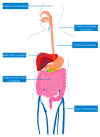Venous Thromboembolism in Patients with Inflammatory Bowel Disease
- PMID: 38202258
- PMCID: PMC10780135
- DOI: 10.3390/jcm13010251
Venous Thromboembolism in Patients with Inflammatory Bowel Disease
Abstract
Patients diagnosed with inflammatory bowel disease (IBD), which encompasses Crohn's disease and ulcerative colitis, experience chronic inflammation of the gastrointestinal tract. Those with IBD face a higher risk of developing venous thromboembolism (VTE) compared to individuals without IBD. This escalated risk is associated with various factors, some modifiable and others non-modifiable, with disease activity being the primary concern. Interestingly, Janus Kinase inhibitors approved for the treatment of IBD may be associated with an increased risk of VTE but only in patients that have other underlying risk factors leading to an overall increased VTE risk. Several recognized medical societies have recommended the use of VTE prophylaxis for hospitalized individuals with IBD. The association between VTE and IBD and the need for pharmacologic prophylaxis remains under-recognized. Increased awareness of this complication can hopefully protect patients from a potentially deadly complication.
Keywords: Crohn’s disease; IBD; VTE; hospitalization; inflammatory bowel disease; prophylaxis; surgery; ulcerative colitis; venous thromboembolism.
Conflict of interest statement
The authors declare no conflicts of interest.
Figures
References
-
- Ng S.C., Shi H.Y., Hamidi N., Underwood F.E., Tang W., Benchimol E.I., Panaccione R., Ghosh S., Wu J.C.Y., Chan F.K.L., et al. Worldwide incidence and prevalence of inflammatory bowel disease in the 21st century: A systematic review of population-based studies. Lancet. 2017;390:2769–2778. doi: 10.1016/S0140-6736(17)32448-0. - DOI - PubMed
Publication types
LinkOut - more resources
Full Text Sources



